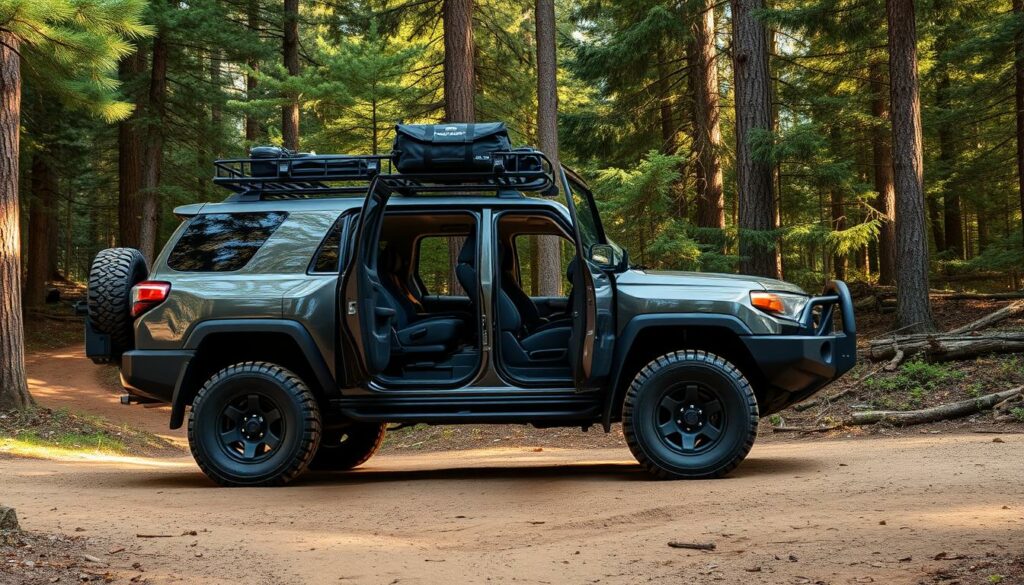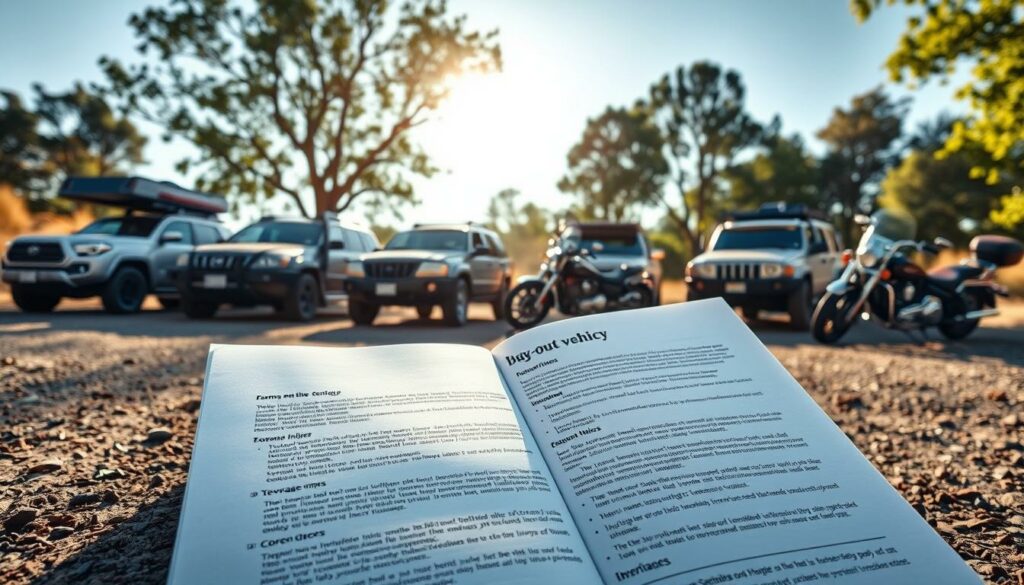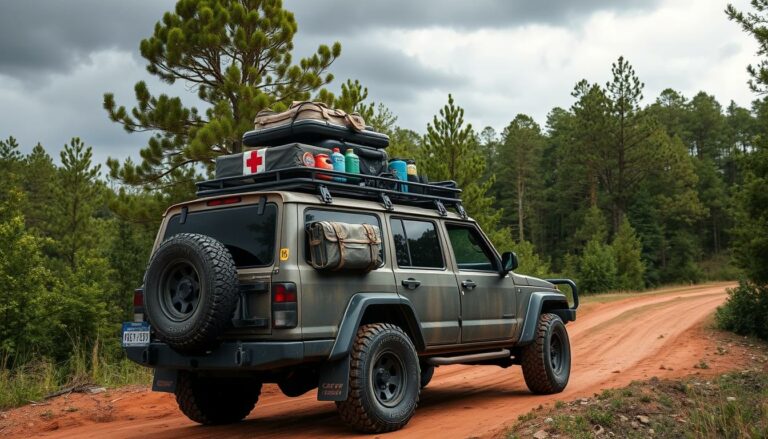When disaster strikes, having a reliable escape vehicle is key. A bug-out vehicle (BOV) is more than just a car. It’s a lifeline that offers mobility, shelter, and security. Choosing the right BOV means looking at its durability, capacity, and how well it adapts to different situations.
This guide will help you make a smart choice. It will improve your chances of survival in emergencies.
Key Takeaways
- Durability is essential in a survival vehicle to avoid breakdowns during critical times.
- Off-road capabilities are a must-have for a bug-out vehicle to handle rough terrains.
- Ample storage space increases long-term survival chances by carrying essential supplies.
- Fuel efficiency is critical, as fuel might be scarce during emergencies.
- Vehicles with customizable features provide flexibility for specific emergency needs.
- Proper modifications can significantly enhance the effectiveness of a bug-out vehicle.
- In emergency preparedness, timely planning and vehicle readiness are vital.
Understanding Bug-Out Vehicles: What You Need to Know
Bug-out vehicles (BOVs) are key for emergency preparedness. They help people and families leave quickly and safely. Knowing what they are and why they’re important is vital.
Choosing the right bug-out vehicle is important. Most people look for storage space to carry food, water, and medical supplies. SUVs and pickup trucks are top picks because they’re big and can handle rough roads.
About 80% of users want vehicles that can handle tough terrains and keep going even after damage. This shows how important durability is.
Bug-out vehicles must be versatile. They need to handle different situations, like hurricanes or wildfires. Families might need to carry up to three months’ worth of supplies, so lots of storage is a must.
These vehicles also need to be self-reliant. Up to 60% of users carry tools for repairs on the go. Having backup power, like solar panels or generators, makes them last longer.
Navigation and safety are also key. 65% of users rely on local maps if GPS fails. Waterproof tarps and survival blankets are also important for shelter and warmth.
To better understand what makes a good bug-out vehicle, here’s a comparison of key features:
| Feature | Importance (%) |
|---|---|
| Storage Capacity | 75% |
| Off-Road Capabilities | 68% |
| Durability | 80% |
| Emergency Repair Tools | 60% |
| Water Purification Backup | 55% |
| Two-Way Radios | 40% |
| Local Maps | 65% |
| Waterproof Tarps/Survival Blankets | 72% |
Understanding bug-out vehicles is key to making the right choice. They are more than just cars; they are essential for survival in emergencies. They offer the right mix of space, toughness, and flexibility to keep you safe.
Assessing Your Specific Needs for a Bug-Out Vehicle
When picking a bug-out vehicle (BOV), it’s key to think about what you really need. Look at the local area and weather to make sure your vehicle can handle it. For example, if your area gets a lot of snow or floods, you’ll need a vehicle that can handle it, like one with high ground clearance or all-wheel drive.
The size of your BOV is also important. It should have enough room for everyone and all your emergency supplies. Studies show families of five or more need about 15-20 cubic feet for their gear. So, your vehicle needs to be big enough to fit everything comfortably.
Whether you’ll be traveling far or just a short distance is also a big factor. For long trips, you’ll want a vehicle that’s both fuel-efficient and comfortable. Look for one that gets at least 23-27 miles per gallon (MPG) for long trips. But if you’ll be taking shorter, rougher paths, a 4WD vehicle is better. It can handle different terrains, helping you get to safety faster.
Also, think about how ready your vehicle is for travel. Cars with manual transmissions are often more reliable and save gas. They’re also easier to fix than automatics. Having a trailer hitch adds more space for cargo without cutting down on passenger room, which is great for families.
Lastly, consider how easy it is to fix your BOV. Choose a vehicle with parts that are easy to find and replace. In emergencies, being able to quickly fix your vehicle can be a lifesaver. By looking at your local area and travel plans, you can pick the best bug-out vehicle for you.
| Consideration | Requirement | Example |
|---|---|---|
| Local Geography | High Ground Clearance | Snow-Prone Areas |
| Climate | All-Wheel Drive | Flood Zones |
| Size Requirements | 15-20 Cubic Feet | Family of Five |
| Travel Distance | Fuel Efficiency | 23-27 MPG |
| Terrain Navigation | 4WD | Off-road Routes |
| Travel Readiness | Manual Transmission | Reliability and Mileage |
| Additional Space | Trailer Hitch | Increased Cargo without Compromising Passenger Space |
Popular Bug-Out Vehicle Types: Pros and Cons
Choosing the right bug-out vehicle (BOV) is key for emergency preparedness. SUVs, trucks, and vans are top picks due to their benefits.

SUVs: SUVs stand out for their versatility and space. The Mercedes Benz GLE 63, for instance, can be customized with armor and run-flat tires. They’re great for families and off-road adventures.
Trucks: Trucks are perfect for rough terrains. The Ford Raptor has a 450 horsepower diesel engine, ideal for off-road trips. They’re good for families of three to four, but might use more fuel.
Vans: Vans offer lots of space and comfort. The Ford Transit Cargo Van is great for carrying lots of cargo. They’re not as good on rough terrains but have plenty of room.
- SUVs: Versatility and space; ideal for mixed urban and off-road use.
- Trucks: Strong power for tough terrains; suitable for off-road adventures and moderate cargo capacity.
- Vans: Extensive cargo space and comfort, ideal for transportation of large amounts of gear and multiple passengers.
| Vehicle Type | Pros | Cons |
|---|---|---|
| SUVs | Versatility, Spacious, Suitable for off-road | Potentially lower fuel efficiency |
| Trucks | Powerful engines, Tough terrain capability, Moderate cargo space | Lower fuel efficiency |
| Vans | Comfortable, Extensive cargo space, Customizable storage | Limited off-road capability |
Considerations for Fuel and Efficiency
Choosing the right bug-out vehicle (BOV) means looking at fuel types. We’ll explore Gasoline, Diesel, and Alternatives. Each has its own strengths and weaknesses for emergency situations.
Gasoline: Gasoline is easy to find and burns clean. Cars on gasoline go fast and far. But, it’s key to think about how much fuel you’ll need, as it might be hard to find in emergencies.
Diesel: Diesel engines have more power and last longer than gasoline ones. They use less fuel, which is great for long trips. Plus, diesel is often found in rural areas, making diesel engines useful for bug-outs.
Alternative Fuels: Options like biodiesel and electric cars are becoming popular. Biodiesel is green and works well with engines. Electric cars are good for the planet and can charge from the sun.
It’s important to think about fuel efficiency. Hypermiling can make your car go 20% to 60% farther on a tank. Finding a balance between fuel efficiency and power is key. This ensures your car can handle tough roads and heavy loads on long trips.
| Fuel Type | Availability | Efficiency | Torque | Environmental Impact |
|---|---|---|---|---|
| Gasoline | High | Moderate | Moderate | Moderate |
| Diesel | Moderate | High | High | Lower than Gasoline |
| Alternative Fuels | Variable | Variable | Varies | Low to Zero |
Choosing the right fuel for your bug-out vehicle is key. It affects how ready you are for tough situations. A balanced choice means your vehicle will be strong and efficient, helping you when it counts most.
Essential Modifications for an Effective Bug-Out Vehicle
Turning your vehicle into a bug-out vehicle (BOV) means making key changes. These changes make it better for emergencies. The Jeep Wrangler is great for off-road adventures, thanks to its design and extra features like big tires and winches.
Making your BOV better means adding good storage solutions for gear and supplies. This can make room for more stuff, up to 40%. The Jeep Gladiator also has lots of space for survival gear.
For a reliable BOV, off-road upgrades are key. Better suspension and tires help a lot. The Jeep Wrangler, for example, gets even better with solid axles and special suspension. Also, the right off-road shocks can improve how it handles without big changes.
Safety is also very important. Things like brush guards and strong bumpers protect your vehicle. Aftermarket lights, like those from Wal-Mart, help you see better. And, a good GPS is vital for finding your way when phones don’t work.
Other things to think about include:
- Recovery equipment: Winches, tow straps for getting past obstacles.
- Communication tools: CB radios or HAM radios for staying in touch.
- Navigation aids: GPS units or compasses for finding your way.
- Medical Kits: They can cut injury risks by 60%.
- Flares and emergency lighting: Used in 70% of emergency kits.
- Tool kits: They help fix problems 80% of the time.
- Spare fuel: It lets you travel much farther.
- Non-perishable food storage: It keeps you fed for over 72 hours.
In short, combining off-road upgrades, smart storage solutions for gear and supplies, and safety features makes your bug-out vehicle ready for anything.
Budgeting for Your Bug-Out Vehicle
When planning your bug-out vehicle (BOV), setting a realistic budget is key. This includes the cost of buying, modifying, and maintaining the vehicle. Choosing between a used or new vehicle affects your budget.
New vehicles like the Jeep Wrangler and Ford Raptor are great for off-road adventures. But, they cost more than used ones. Used vehicles might save money upfront but could need more upkeep.
Bug-out motorcycles, like the Yamaha WR250R and Honda CRF450L, are also worth considering. They are fast, easy to maneuver, and have good storage.
Remember to plan for extra costs for modifications. Key upgrades include:
- Lift kits for more ground clearance
- Larger all-terrain tires for better grip
- Winches for pulling out of tough spots
- Roof racks for extra storage
- Heavy-duty bumper guards for protection
- Cargo organizers for efficient storage
Don’t forget to budget for unexpected repairs and regular maintenance. Planning your budget well helps avoid debt. In the US, 41% of adults can’t handle a $1,000 emergency without debt. Making a personal budget is a key step to financial readiness.
Comparing different vehicles helps set a realistic budget:
| Vehicle Type | Benefits | Cost Considerations |
|---|---|---|
| Jeep Wrangler | Durable, superior off-road capability, ample storage | High initial cost, low gas mileage |
| Jeep Grand Cherokee | Towing capacity, off-road capabilities | Moderate initial cost, relatively high maintenance |
| Bug-Out Motorcycle (Yamaha WR250R) | Low profile, increased maneuverability | Lower initial cost, minimal storage |
By setting a realistic budget, you can prepare for emergencies without financial stress. This careful planning helps avoid debt and ensures you’re ready for anything.
Maintenance and Preparedness for Your Bug-Out Vehicle
Keeping your bug-out vehicle (BOV) in top shape is key. Regular tasks like oil changes, tire checks, and brake inspections are a must. These steps help avoid breakdowns when you need your vehicle most.
It’s also vital to have a full emergency kit in your BOV. Sadly, 70% of households lack a bug-out bag or emergency kit in their vehicle. Having one boosts safety and preparedness by 80%, as surveys show.
Here are some must-haves for your emergency kit:
- First aid supplies: Having a first aid kit can reduce complication rates from injuries by up to 30% during emergencies.
- Non-perishable food: Items like granola and canned goods are ideal as they can last from 2-5 years.
- Water and purification methods: Access to clean water is key, as 75% of vehicle breakdowns last over 24 hours.
- Tools: Essentials such as duct tape and multi-tools are necessary for on-the-spot repairs as 20% of vehicle-related emergencies involve breakdowns.
- Hygiene and sanitation supplies: These can reduce the risk of infection by approximately 50% during emergencies.
- Self-defense tools and safety items: Individuals carrying these report a 40% higher sense of security.
- Portable communication tools: Satellite phones and ham radios ensure reliable contact when local networks fail.
- Cash: It’s essential as electronic systems often fail, peaking at 30% during emergencies.
- Navigation aids: Maps and compasses improve navigation success rates by 50% in unfamiliar areas.
Regularly check your emergency kit, vehicle fluids, and gas levels. These Routine Maintenance Tasks to Prioritize are key to being ready. Studies show that a well-prepared bug-out vehicle kit reduces anxiety by 65%, highlighting its importance.
By focusing on vehicle maintenance and preparedness, you’ll always be ready for any situation. This ensures you can act quickly and effectively during emergencies.
| Item | Benefit |
|---|---|
| First Aid Kit | Reduces injury complication rates by up to 30% |
| Non-Perishable Food | Lasts 2-5 years, ideal for emergencies |
| Water Purification | Crucial for breakdowns lasting over 24 hours |
| Hygiene Supplies | Reduces infection risk by 50% |
| Self-Defense Tools | Boosts sense of security by 40% |
| Communication Tools | Maintain contact even when local networks fail |
| Cash | Essential during electronic system failures |
| Navigation Aids | Improves navigation success rates by 50% |
Securing Your Bug-Out Vehicle for Safety
Keeping your bug-out vehicle safe is key for your safety and privacy in emergencies. Adding anti-theft measures for peace of mind will safeguard your investment. There are many ways to boost your vehicle’s security.
- Immobilizers: Essential in preventing unauthorized starting of your vehicle.
- GPS trackers: Allow real-time tracking, ensuring you can locate your vehicle if it’s stolen.
- Robust locks: Reinforced locks on doors and windows can serve as strong deterrents against break-ins.
Privacy solutions:
- Tinted windows: These help in keeping the vehicle’s interior hidden from prying eyes.
- Curtains: Simple yet effective for concealing the contents and occupants of the vehicle.
With over 70% of car owners lacking an emergency kit, having the right tools is critical. Given that 55% of Americans have faced a roadside emergency, these anti-theft measures for peace of mind are vital.
Extreme weather events show that 38% of individuals use their vehicle for evacuation. This highlights the importance of these security upgrades. By adding these systems, you’ll protect your bug-out vehicle and make it a safe haven in emergencies.
Legal Considerations for Bug-Out Vehicles
When planning your bug-out strategy, it’s key to understand the legal side. Understanding Insurance Requirements and following local rules make sure your vehicle is ready for emergencies.

Start by learning about your state’s vehicle emergency laws. Many states have rules for vehicles, like emission standards and safety features. You need to follow these to avoid fines or penalties during an evacuation.
Vehicle Registration and Local Regulations: Make sure your vehicle is registered and follows local rules. This includes knowing any extra paperwork needed for special vehicles, like surplus military ones. For example, states like Colorado and California need an SF97 form for surplus vehicles like the LMTV, to make them street legal.
Then, understanding insurance requirements is important. Your bug-out vehicle should have full insurance coverage, including off-road if needed. This insurance protects against damage or theft during a crisis, giving you peace of mind and financial safety.
Legal Compliance and Regulatory Awareness: Keep up with laws on vehicle modifications. For example, adding snorkel kits or improving fuel efficiency must follow state laws. Following the law ensures your modifications don’t affect your registration or insurance.
Lastly, think about the challenges of moving or selling your bug-out vehicle. Knowing the legal paperwork, like bills of sale and title transfers, helps in quick responses during emergencies. Always keep up with current laws to keep your bug-out vehicle legal and ready when you need it.
Real-Life Experiences and Case Studies in Bug-Out Vehicles
Looking at real survival stories and lessons from bug-out situations is very helpful. Bill from upstate New York is a great example. He was worried about dams and got ready for emergencies. He packed bug out bags for his family and made sure important documents were ready.
Super Storm Sandy showed how important community help is. Bill worked with his neighbors to share resources like gasoline and water. He also had a big water cistern, showing the need for sustainable resources.
The Jeep Cherokee hacking case is a lesson in digital security. Miller and Valasek found big problems in Chrysler vehicles from 2013 to 2015. They could control the car’s steering and brakes remotely. Chrysler fixed it, but it was a big scare. It shows how important digital security is in bug-out vehicles.
Source Links
- https://www.mirasafety.com/blogs/news/best-bug-out-vehicle-guide?srsltid=AfmBOoo-Y-HzeuBr51cwN04K6N0WyqaXsGASMV-jR8uEJfIcpljn_YMr
- https://www.therangerstation.com/tech/choosing-a-bug-out-vehicle/
- https://goodneighborsupply.com/blogs/news/the-best-bug-out-vehicles-of-2023?srsltid=AfmBOoo-VTktgOkByxfLU8W2QitVCUJMjYxG4C72KrS2HuCTz6s6rUED
- https://trueprepper.com/bug-out-vehicle/
- https://www.mirasafety.com/blogs/news/best-bug-out-vehicle-guide?srsltid=AfmBOoqbUf-PelbLx91lrI889vlUiosPSXstAdj3CYp5GaQJd_lFiqwP
- https://cityprepping.com/blog/skill/how-to-build-a-bug-out-vehicle/
- https://www.thebugoutbagguide.com/best-bug-out-vehicle-checklist/
- https://www.utahpreppers.com/2009/09/bug-out-vehicle-project/
- https://survivalist101.com/tutorials/ultimate-bug-out-bag/bug-out-vehicle/
- https://armormax.com/blog/best-bug-out-vehicles-every-thing-you-need-to-know-about/
- https://goodneighborsupply.com/blogs/news/the-best-bug-out-vehicles-of-2023?srsltid=AfmBOor6Iu-AWFU6bCJGiLxRQj4iYIz41Hwzqy-Pz83vPru81njMrJDt
- https://valleyfoodstorage.com/blogs/inside-vfs/best-bugout-vehicles?srsltid=AfmBOopHlK6JwzXdUeo2aIME44a7qDBM7JGA1wygiSDwayqAl8C5Den9
- https://www.superessestraps.com/blogs/news/bugging-out-via-vehicle-a-bugout-vehicle-guide?srsltid=AfmBOopB4IGH5BrIif7kzTbI6MlZY8NigbxqnyocMjDD4tQmkhDKyRTM
- https://www.mirasafety.com/blogs/news/best-bug-out-vehicle-guide?srsltid=AfmBOooKYcFJqu7Dj_BgfMUvZ7CWn4cL_Kdb121CRHp9lDR66c4IjcVE
- https://www.tactical.com/a-beginners-guide-to-bug-out-vehicles/
- https://survivalsherpa.wordpress.com/2012/09/04/the-bug-out-vehicle-bov-mods-and-more/
- https://www.extendobed.com/things-that-every-bug-out-vehicle-needs/
- https://www.mirasafety.com/blogs/news/best-bug-out-vehicle-guide?srsltid=AfmBOorgLwXHrNiO4oPFfa72iUx6VsLaJbBmd004U73vDFnbvqSwcGuG
- https://goodneighborsupply.com/blogs/news/the-best-bug-out-vehicles-of-2023?srsltid=AfmBOoofZ4zwud3Sny8k8UEYlCWikDJ1UqT_Zvh2Ez-mECuBZEP1_0kA
- https://trueprepper.com/financial-planning/
- https://premierbodyarmor.com/blogs/pba/car-bug-out-bags?srsltid=AfmBOoq3vkwyh-RsBefImLwlO2Qp5CXVKFaBuPyBLi7GJkIu_VtHrDOf
- https://offgridsurvival.com/vehicleprepping/
- https://www.mirasafety.com/blogs/news/best-bug-out-vehicle-guide?srsltid=AfmBOorvTS0E3i2Z-rIqPFpkMpTimPPRzQJ6gMNkS5l9LPitDu3IKu4N
- https://www.mirasafety.com/blogs/news/best-bug-out-vehicle-guide?srsltid=AfmBOoqWSOiptohDCOsmfHx_KMGwGFTZknVzwddwtrtbGNPSpOMi7t9P
- https://premierbodyarmor.com/blogs/pba/car-bug-out-bags?srsltid=AfmBOopA5ibLQAAjN8D6Vw8ptXcmnZaDZJVLGSu6IzaKlD28S0F9glgc
- https://www.superessestraps.com/blogs/news/bugging-out-via-vehicle-a-bugout-vehicle-guide?srsltid=AfmBOoruGqZsoTE2uBVbU28kui8Ag7_ld9mHpiVtouVk8DOVpJ4f4NHb
- https://www.dirtlegal.com/blog/in-support-of-lmtvs-ideal-bugout-rigs-for-an-uncertain-future?srsltid=AfmBOoqOw88u0rsh0fAaRXPYV72s6kbS83uOUiWRP3HLM0YjOIFo0uQD
- https://www.instructables.com/How-to-Build-a-Full-sized-All-Terrain-Tracked-Vehi/
- https://www.thebugoutbagguide.com/reader-case-study-family-preparedness/
- https://www.wired.com/2015/07/hackers-remotely-kill-jeep-highway/

